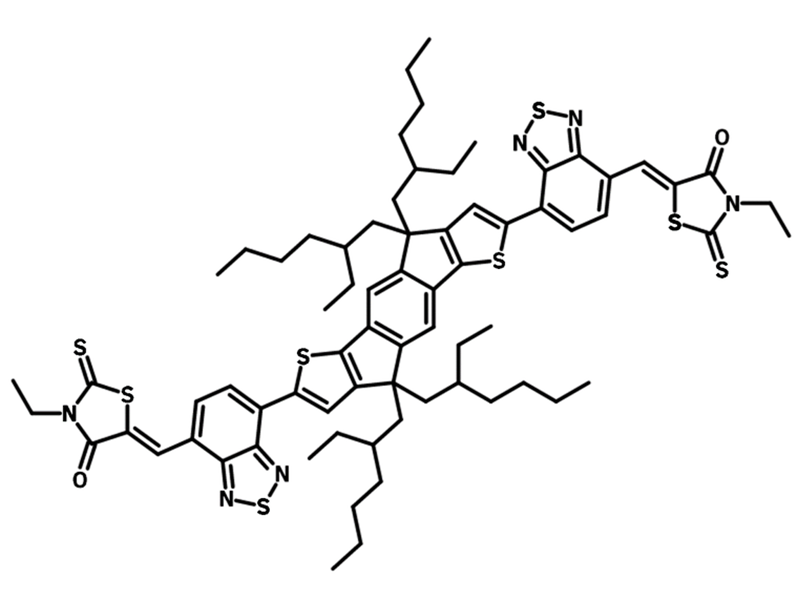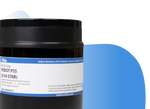A non-fullerene acceptor
Used to enhance the performance of organic solar cells
Specifications | Pricing and Options | MSDS | Literature and Reviews
EH-IDTBR (CAS number 2102510-60-9) is a small molecule with an indacenothiophene core capped with two benzothiadiazole-linked rhodanine groups. Same as o-IDTBR, EH-IDTBR also possesses an acceptor-acceptor–donor–acceptor-acceptor (A-A'–D–A'-A) structure and is widely used as a non-fullerene acceptor in organic/polymer solar cells. EH-IDTBR has a HOMO energy level at −5.6 eV and a LUMO at −3.9 eV, resulting in bandgap of 1.7 eV. EH-IDTBR is typically blended with the active material to create a bulk heterojunction as the active layer in solar cells. In a solar cell device of ITO/ZnO/EH-IDTBR/PffBT4T-2OD/MoO3/Ag, EH-IDTBR has demonstrated improved stability with negligible 'burn-in' efficiency loss compared to PffBT4T-2OD:PC71BM devices (PCE losses after 60 h of 0 ± 4% and −26± 8%, respectively).
With addition of EH-IDTBR (18%) as the third component to the active layer of PCE10:F8IC, the PCE is increased from 7.2% to 12.3%. This increase can be attributed to the reduced energetic disorder in hole and electron transport facilitated by EH-IDTBR.
Enhanced OPVs performance
PCE increased from 7.2% to 12.3%
Worldwide shipping
Quick and reliable shipping
Non-fullerene acceptor
Non-fullerene acceptor in organic/polymer solar cells
Improve OPVs life-time
Negligible "burn-in" efficiency loss
Device structure: ITO/ZnO/EH-IDTBR-PffBT4T-2OD/MoO3/Ag [3]
| Thickness (nm) | VOC (V) | JSC (mA cm-2) | FF (%) | PCE (%) |
|---|---|---|---|---|
| 70nm (PffBT4T-2OD:EH-IDTBR 1:1.4) | 1.08 | 14.6 | 60.0 | 9.5 |
Device structure: ITO/PEDOT:PSS AI 4083/EH-IDTBR-PCE10-F8IC/DPO/Ag [5]
| Thickness (nm) | VOC (V) | JSC (mA cm-2) | FF (%) | PCE (%) |
|---|---|---|---|---|
| 160-170nm(EH-IDTBR:F8IC:PCE10 1:1.4:0.3) | 0.66 | 24.6 | 71.4 | 12.3 |
EH-IDTBR is available to buy online in quantities from 100 mg to 1 g (please contact us for larger orders). Larger quantities offer the best value, while smaller quantities may be more suitable for some applications. Eligible orders ship free.
General Information
| CAS Number | 2102510-60-9 |
|---|---|
| Chemical Formula | C72H88N6O2S8 |
| Purity | 98% |
| Full Name | (5Z)-3-Ethyl-2-sulfanylidene-5- [[4-[9,9,18,18-tetrakis(2-ethylhexyl)-15-[7-[(Z)-(3-ethyl-4-oxo-2-sulfanylidene-1,3-thiazolidin-5-ylidene)methyl]-2,1,3-benzothiadiazol-4-yl]-5,14-dithiapentacyclo[10.6.0.03,10.04,8.013,17]octadeca-1(12),2,4(8),6,10,13(17),15-heptaen-6-yl]-2,1,3-benzothiadiazol-7-yl]methylidene]-1,3-thiazolidin-4-one |
| Molecular Weight | 1326.03 g/mol |
| Absorption |
λmax 642 nm (CH2Cl2) [2] λmax 675 nm (film) [2] |
| Emission |
λmax 738 nm (CH2Cl2) [2] λmax 766 nm (film) [2] |
| HOMO/LUMO |
HOMO = −5.6 eV LUMO = −3.9 eV [1] |
| Melting Point | 211 – 216 °C |
| Solubility | Chloroform, chlorobenzene |
| Appearance | Black powder |
| Synonyms | N/A |
| Classification / Family | NFAs, Non-fullerene acceptors, organic semiconducting materials, low band-gap small molecule, small molecular acceptor, organic photovoltaics, polymer solar cells, NF-PSCs, NLOs |
Chemical Structure

Pricing
| Product Code | Quantity | Price |
|---|---|---|
| M2413 | 100 mg | ]] £280 |
| M2413 | 250 mg | £600 |
MSDS Documentation
Literature and Reviews
- Mid-gap trap state-mediated dark current in organic photodiodes, O. Sandberg et al., Nat. Photonics, 17, 368–374(2023); DOI: 10.1038/s41566-023-01173-5.
- Highly broadband NLO response of acceptor-donor-acceptor materials with a planar conformation, Y. Huang et al., Mater. Adv., 2, 2097(2021); DOI: 10.1039/d0ma00918k.
- An efficient, "burn in" free organic solar cell employing a nonfullerene electron acceptor, H. Cha et al., Adv. Mater., 29(33), 1701156(2017); DOI: 10.1002/adma.201701156.
Related Products
Semiconducting polymers for bulk heterojunction, OPV, OLED, OFET and perovskite interfaces and solar cell research.


